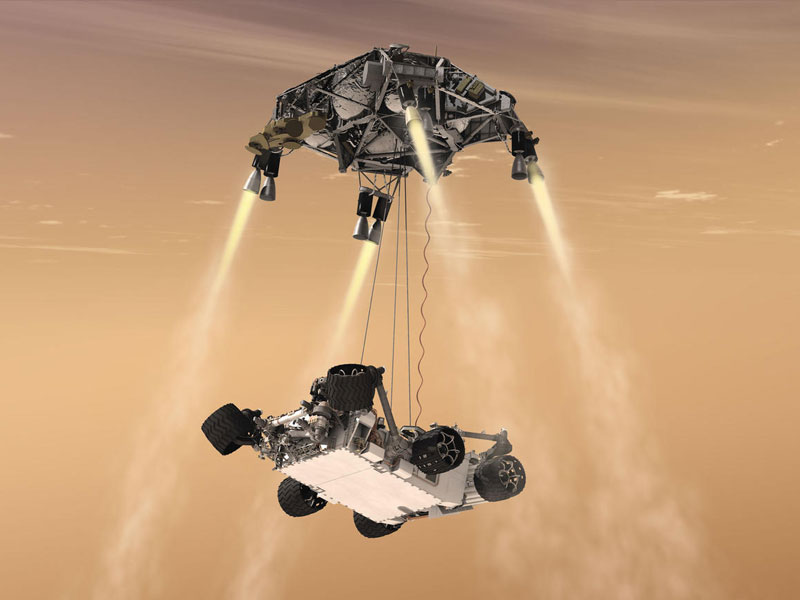Follow Perseverance to the Red Planet
Perseverance will touch down on Mars on Thursday, Feb. 18, 2021, at approximately 12:30 p.m. PST (3:30 p.m. EST).
Landing on Mars is Hard
During landing, the rover plunges through the thin Martian atmosphere, with the heat shield first, at a speed of over 12,000 mph (about 20,000 kph). A parachute and powered descent slow the rover down to about 2 mph (three-fourths of a meter per second). A large sky crane then lowers the rover on three bridle cords to land softly on six wheels. Read all about the rover’s harrowing entry, descent and landing.
Landing at Jezero Crater
The rover’s new home is Jezero Crater, a large impact crater about 28 miles wide (45 kilometers wide) just north of the Martian equator. Jezero once contained a lake, which scientists think is one of the most ideal places to find evidence of ancient microbial life.
If life exists anywhere else in our solar system, chances are, it might be at Jezero Crater. The main question Perseverance is trying to answer is: Was there ever ancient life on Mars?
Take a Virtual Journey with Perseverance!
The Perseverance Rover will launch between July 30 and Aug. 15, 2020 and head to Jezero Crater, where it will land at the foot of a river delta which was clearly a lake at the time microbial life was flourishing on Earth.
On June 30th, the American Museum of Natural History’s Director of Astrovisualization, Carter Emmart, led the public on an exploration of this exciting landing site as we flew over it using OpenSpace, NASA-supported software. We saw why Jezero Crater was chosen and the features it has to offer for this latest in NASA’s series of Mars rovers to investigate past conditions which could have supported life.
This live OpenSpace webcast was brought to you by the STAR Library Network’s NASA@ My Library program in partnership with the Lunar and Planetary Institute, the American Library Association, and the American Museum of Natural History.
Digital App: Fly to Mars
We can only send spacecraft to Mars every two years. Have you ever wondered why? This simple simulation lets you launch a spacecraft from Earth to Mars. All you have to do is decide when to launch and we take care of the amount and direction of thrust. Easy, right? Available on smartphones and tablets!
Also, download the Rover Coder App to test your programming skills.
NASA STEM @ Home Resources
Below we have assembled a collection of NASA STEM @ Home resources that are “ready to share” with patrons.
NASA Mars 2020 Mission
The Mars 2020 mission with its Perseverance rover is part of NASA’s Mars Exploration Program, a long-term effort of robotic exploration of the Red Planet. The Mars 2020 mission addresses high-priority science goals for Mars exploration.
Main Objective: The Perseverance rover will seek signs of ancient life and collect rock and soil samples for possible return to Earth.
Webinar Opportunity*
Take Your Patrons to Mars
NASA is about to launch the Mars 2020 mission – and now is the time to get your patrons excited! The Perseverance rover will launch between July 17-August 11, 2020, and will land on Mars in February 2021.
Invite your patrons to participate in its journey! Hear from NASA Mars scientists, learn some activities you can conduct online or in-person, and make plans to hold your own virtual (or in-person) launch or landing parties!
* Library staff only – not to be shared with patrons.

The Detective Onboard
Mars is a long way from 221B Baker Street, but one of fiction’s best-known detectives will be represented on the Red Planet after NASA’s Perseverance rover touches down on Feb. 18, 2021.
An instrument called SHERLOC will, with the help of its partner WATSON, hunt for signs of ancient life by detecting organic molecules and minerals.


 Carter Emmart (Director of Astrovisualization)
Carter Emmart (Director of Astrovisualization) Dr. Elizabeth Rampe (NASA Johnson Space Center Exploration Mission Scientist)
Dr. Elizabeth Rampe (NASA Johnson Space Center Exploration Mission Scientist) Dr. Germán Martínez (LPI Staff Scientist)
Dr. Germán Martínez (LPI Staff Scientist) Dr. Kennda Lynch (LPI Staff Scientist)
Dr. Kennda Lynch (LPI Staff Scientist)